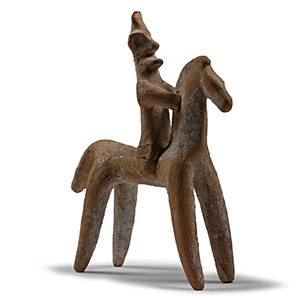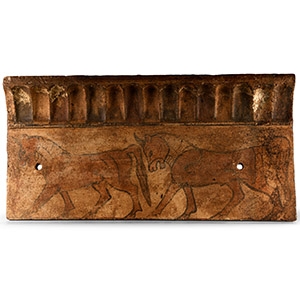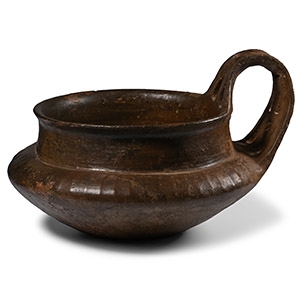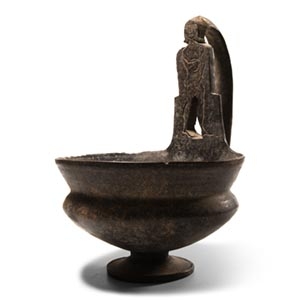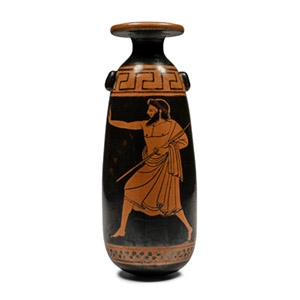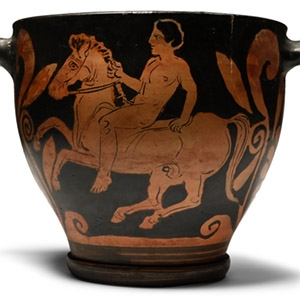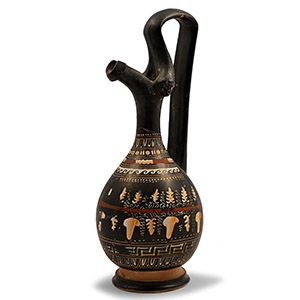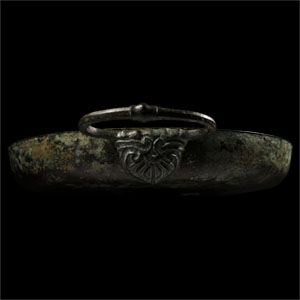Home > Auctions > 4 - 9 March 2025
Ancient Art, Antiquities, Books, Natural History & Coins
Acquired in the mid 1980s-1990s.
Private collection, Switzerland, thence by descent.
Private collection, since the late 1990s.
This lot has been checked against the Interpol Database of stolen works of art and is accompanied by search certificate number no.12214-222196.
This lot has been cleared against the Art Loss Register database, and is accompanied by an illustrated lot declaration signed by the Head of the Antiquities Department, Dr Raffaele D’Amato.
Cf. similarly formed item in Metropolitan Museum of Art under accession no.59.48.14.
with Bonhams, London, 29 April 2009, no.339.
Accompanied by a copy of an Art Loss Register certificate no.S00075782.
Accompanied by a copy of the relevant Bonham's catalogue pages.
This lot is accompanied by an illustrated lot declaration signed by the Head of the Antiquities Department, Dr Raffaele D’Amato.
Cf. similar but less elaborate version of the type in the British Museum under accession no.1896,0201.20.
Mr F.D. collection, acquired on the European art market, 1975 to present.
This lot is accompanied by an illustrated lot declaration signed by the Head of the Antiquities Department, Dr Raffaele D’Amato.
Cf. Karageorghis, V., Cipro, Crocevia del Mondo Mediterraneo orientale 1600-500 a.C., Milano, 2002, figs.377, 383.
The most popular animals in Cypriot coroplasts of the 8th and 7th centuries B.C. were horses, with or without riders, with long necks and decorated bodies. It is worth remembering that the horse in this period represented a status symbol for the military aristocracy and that bodies of sacrificed horses have been found in royal tombs.
Acquired on the European art market between 1960s-1980s.
Property of a gentleman.
with Bertolami Fine Arts Ltd, Auction 66, no.1.
Accompanied by an academic report by Dr Raffaele D’Amato.
This lot has been checked against the Interpol Database of stolen works of art and is accompanied by search certificate number no.12162-218594.
This lot has been cleared against the Art Loss Register database, and is accompanied by an illustrated lot declaration signed by the Head of the Antiquities Department, Dr Raffaele D’Amato.
Cf. Torelli, M., Gli Etruschi, Cinisello Balsamo, 2000, p.597 (Campana Plaques), for similar architectural examples; Wikander, O., 'The Archaic and Etruscan Sima' in De Puma, D., Penny Small, J., Murlo and the Etruscans, Art and Society in Ancient Etruria, London, 1994, pp.47-63, figs.48-49-50; see also Etruscan painted terracotta revetment plaques with chariot processions and running dogs from the Vigna Marini-Vitalini urban sanctuary, Caere, inv.no. HIN 29-30.
Terracotta plaques like this sima were used in the pediments of temples (Minerva at Veii, Portonaccio Sanctuary, 540-530 BC), or decorated the architecture of tombs. The procession of the bulls recalls the style of painting on a similar slab with a procession of hunting dogs, probably from Caere.
Acquired from Mr Eugene Berman circa 1960.
From the private collection of Mr Ulfert Wilke.
In the collection of Dr Howard Sirak, Columbus, Ohio, USA; acquired from the above in 1969.
Ancient Resource Auctions, California, USA, May 2020.
Property of a South Australian private collector, with collection reference 20.02.
Accompanied by a detailed collector's catalogue page including description and photograph.
This lot is accompanied by an illustrated lot declaration signed by the Head of the Antiquities Department, Dr Raffaele D’Amato.
Cf. Dohan, Italic Tomb-Groups in the Pennsylvania Unversity Museum, p.83, no.7, pl.44, Vulci Tomb 51, for a smaller parallel.
De Puma, Etruscan and Villanovan Pottery: A Catalogue of Italian Ceramics from Midwestern Collections, no.17.
The de Puma catalogue cites this piece as no. 5.5 from the Sirak Collection (original sticker is on base; note De Puma’s appraisal does not provide a concordance with Wilke). The catalogue was for the exhibition at the University of Iowa Museum of Art from 17 March to 30 April 1971. Richard De Puma appraised Sirak’s collection of ancient pottery on 18 September 1979; Inv. 20.02 was noted as appraisal item 15 and valued at USD 650. Old collection sticker '188' on base; overlain is sticker from Sirak collection, 'LR 3V'. Sticker 147B refers to the lot number for the first time it was offered at auction by Ancient Resource Auctions in 2015.
English private collection.
This lot is accompanied by an illustrated lot declaration signed by the Head of the Antiquities Department, Dr Raffaele D’Amato.
with Hirsch Auction, 23 September 2006, no.666.
Accompanied by an academic report by Dr Raffaele D’Amato.
This lot has been checked against the Interpol Database of stolen works of art and is accompanied by search certificate number no.12463-228723.
Accompanied by thermoluminescence analysis report no.06280606 by Laboratory Kotalla.
This lot has been cleared against the Art Loss Register database, and is accompanied by an illustrated lot declaration signed by the Head of the Antiquities Department, Dr Raffaele D’Amato.
Cf. for similar pottery Beazley, Attic Red-Figure Vase-Painters, Oxford, 1963, no.717.230; Boardman, Athenian Red Figure Vases, The Classical Period, London, 1989, fig.62; for the shape, The Paul Getty Museum, Greek vases, Molly and Walter Bareiss Collection, Malibu, 1983, p.88.
The men depicted on this vessel are each holding an elegant walking stick appropriate to Athenian citizens. They both seem to be in a drunken rage, and seemingly have just left a drinking party: the consequences of immoderate drinking were a favourite subject for vessel decorations.
Private collection, 1970s.
with Hotel des Ventes, Genève, 8-11 December 2008, no.623.
Accompanied by an academic report by Dr Raffaele D'Amato.
Accompanied by a copy of an Art Loss Register certificate no.S00036548.
This lot has been checked against the Interpol Database of stolen works of art and is accompanied by a search certificate number no.12516-232110.
This lot has been cleared against the Art Loss Register database, and is accompanied by an illustrated lot declaration signed by the Head of the Antiquities Department, Dr Raffaele D’Amato.
Cf. Trendall, A.D.I., ‘Paestan Pottery: a Revision and a Supplement, in Papers of the British School at Rome, 1952, no.20, pp.1-53, pl.V,b, for similar form of skyphos with different iconography.
Ex German collection, 1970.
with Galerie Chenel, Paris, 22 July 2008.
This lot is accompanied by an illustrated lot declaration signed by the Head of the Antiquities Department, Dr Raffaele D’Amato.
Cf. similar item (undecorated) in the Metropolitan Museum of Art, New York, under accession no.41.162.237; cf. also a lekythos with image of an Amazon in Isler, H.P., Archäologische Sammlung der Universität Zürich. Jahresbericht Nr. 33, 2006-2007, Zürich, 2007, p.6, under nos.1259-1292.
The word lekythos had a wide meaning in ancient Greece, probably generally meaning all oil jugs, including the athletes' oil bottle (now called aryballos) as well as the types now given this name by archaeologists. Certain lekythoi resemble certain oenochoe superficially, at a first glance. Oenochoes, however, were wine-pitchers and in most cases were larger than the lekythoi, which were small jugs for oil, perfumes, etc.
Ex Fred Bentley Sr. GA (1926-2019).
with Ahlers & Ogletree Inc., USA, 10 November 2023, no.343.
Private collection, UK.
This lot is accompanied by an illustrated lot declaration signed by the Head of the Antiquities Department, Dr Raffaele D’Amato.
Ex P.M. Suter, 1970s-1994.
with Cahn Auktionen AG, 3 November 2012, no.184.
Accompanied by a copy of an Art Loss Register certificate no.S00069492.
This lot is accompanied by an illustrated lot declaration signed by the Head of the Antiquities Department, Dr Raffaele D’Amato.
Cf. Maierovskii III Burial-mound no. 4/2002, Burial no. 3B, Moscow, State Historical Museum, inv. no. 112873, list Б 2078/77, in Treister, M., 'Parthian and Early Sasanian 'Imports' in the Burials of the Nomads of Eastern Europe (2nd Century BCE-3rd Century CE)' in Choref, M.M., Materials in Archaeology and History of Ancient and Medieval Crimea, Moscow, 2018, pp.118-210, fig.4, 1-3, for similar.
Acquired before 1983.
Ex London gallery, 1990s.
This lot has been checked against the Interpol Database of stolen works of art and is accompanied by a search certificate number no.12519-231946.
This lot has been cleared against the Art Loss Register database, and is accompanied by an illustrated lot declaration signed by the Head of the Antiquities Department, Dr Raffaele D’Amato.
The Greek deity Artemis was the goddess of hunting, associated with wild animals and woodland as well as childbirth. She was often linked with folk magic and witchcraft due to her role as goddess of the moon. She was identified by the Romans with the goddess Diana. Artemis was born, with her twin brother Apollo, on the island of Delos, daughter of Zeus and Leto. Homer refers to her as Artemis Agrotera, Potnia Theron: "Artemis of the wildland, Mistress of Animals". Her best-known cult sites were on the island of Delos, in Attica at Brauron and Mounikhia, and in Sparta. She was often depicted in paintings and statues in a forest setting, carrying a bow and arrows, and accompanied by a deer. In Greek classical art, she is usually portrayed as a maiden huntress: young, tall and slim, clothed in a girl's short skirt, with hunting boots, a quiver, a bow and arrows. When portrayed as a moon goddess, Artemis wore a long robe and sometimes a veil covering her head. Her darker side is revealed in some vase paintings, where she is shown as the death-bringing goddess whose arrows fell young maidens and women, such as the daughters of Niobe. Artemis was also identified with the ancient mother goddess at Ephesus in modern-day Turkey and it was there that a huge temple was built in her honour, long recognised as one of the Seven Wonders of the World.
25 - 36 of 3546 LOTS

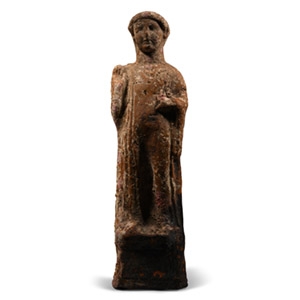
.jpg)
